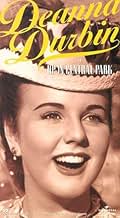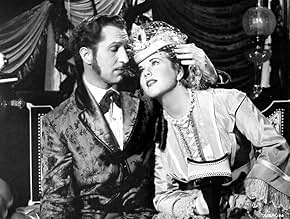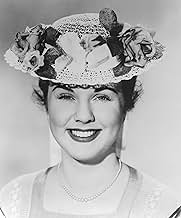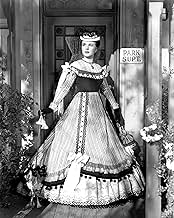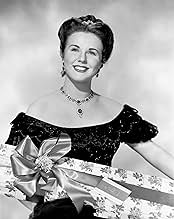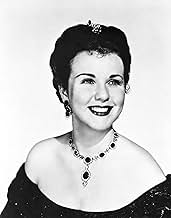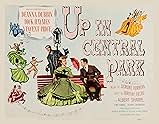Ajouter une intrigue dans votre langueA newspaper reporter and the daughter of an immigrant maintenance man help expose political corruption in New York City.A newspaper reporter and the daughter of an immigrant maintenance man help expose political corruption in New York City.A newspaper reporter and the daughter of an immigrant maintenance man help expose political corruption in New York City.
- Réalisation
- Scénario
- Casting principal
Nellie Fisher
- Dancer
- (as Nelle Fisher)
Boyd Ackerman
- Policeman
- (non crédité)
Patricia Alphin
- Guest
- (non crédité)
Alice Backes
- Swedish Immigrant Girl
- (non crédité)
G. Pat Collins
- Ward Heeler
- (non crédité)
Avis à la une
Durbin and Price are in top form; both are charming, and hit just the right light note in their acting style. Dick Haymes sings very well, but lacks charisma and spark as an actor. The actor playing Durbin's Irish father is strictly from the Barry Fitzgerald school of ersatz Blarney.
Contrary to what another reviewer said, this 100% soundstange shot film shows all to clearly that Universal didn't spend much money on it. Sets are unusually limited in scope for a musical. One example: In one number immigrant Durbin on the deck of a boat coming to America sings about the new countries glories. Not only is the boat deck tiny with the only backdrop a painted sky, but there is not one shot showing what she is singing about, what is supposedly inspiriting her song.
The plot and characters are hardly realistic, but work just fine for a musical. The dialog is well written, better than in the majority of musicals of this era.
The music, what there is of it, has big, well written orchestrations, and the fidelity is excellent on the VHS tape. Johnny Green is credited as composer- music director, and I believe he was head of MGM's music department at the time, so I suspect Universal farmed out musical duties to MGM (L.B. Mayor was father in law to Universal's chief). If so, it was a good decision.
As was standard practice in this era, only a few of the songs written for the stage show on which the film was based made it to the film. The glaring omission is "We'll Be Close As Pages In A Book", which I believe is the only song from the theater production to become popular and have a life outside of the show. It's not in the film, but is very prominently featured in the instrumental title music and is the music which closes the film. Makes me suspect they filmed the song, but cut it before the film was released.
Contrary to what another reviewer said, this 100% soundstange shot film shows all to clearly that Universal didn't spend much money on it. Sets are unusually limited in scope for a musical. One example: In one number immigrant Durbin on the deck of a boat coming to America sings about the new countries glories. Not only is the boat deck tiny with the only backdrop a painted sky, but there is not one shot showing what she is singing about, what is supposedly inspiriting her song.
The plot and characters are hardly realistic, but work just fine for a musical. The dialog is well written, better than in the majority of musicals of this era.
The music, what there is of it, has big, well written orchestrations, and the fidelity is excellent on the VHS tape. Johnny Green is credited as composer- music director, and I believe he was head of MGM's music department at the time, so I suspect Universal farmed out musical duties to MGM (L.B. Mayor was father in law to Universal's chief). If so, it was a good decision.
As was standard practice in this era, only a few of the songs written for the stage show on which the film was based made it to the film. The glaring omission is "We'll Be Close As Pages In A Book", which I believe is the only song from the theater production to become popular and have a life outside of the show. It's not in the film, but is very prominently featured in the instrumental title music and is the music which closes the film. Makes me suspect they filmed the song, but cut it before the film was released.
"Up in Central Park" is set in New York City in the 19th century. Boss Tweed (Vincent Price) and his political machine (Tammany Hall) have been in charge of the city for years...and cheating, graft and voting irregularities will keep him in power. At the time of the election, an Irish man and his daughter, Rosie (Deanna Durbin), arrive in the city...and are paid to vote the Tammany Hall candidates even though they aren't citizens. Tweed himself takes a special interest in them...mostly because he finds Rosie to be gorgeous. She, in turn, is smitten with him...unaware or perhaps unwilling to accept the man's evil reputation might just be true. A reporter (Dick Haymes) is fighting Tammany Hall and he tries to get Rosie to see the light...but getting her attitude to change will be a tall order, as around her he's the perfect gentleman. What's going to come of naive Rosie and Boss Tweed?
This is an enjoyable film but not without its problems. The first one I noticed was that although Rosie's dad has a thick Irish accent, Rosie sounds like a native-born American! She didn't even attempts a trace of the Irish accent...and it made little sense. The second was that even for a Durbin film the musical numbers were dull and too high brow...especially the ballet sequence. Third, and worst of all, the ending was very abrupt and unsatisfying. On the positive side, Vincent Price was great as the slimy Tweed and the story mildly interesting. But to me, the negatives slightly outweigh the positives.
This is an enjoyable film but not without its problems. The first one I noticed was that although Rosie's dad has a thick Irish accent, Rosie sounds like a native-born American! She didn't even attempts a trace of the Irish accent...and it made little sense. The second was that even for a Durbin film the musical numbers were dull and too high brow...especially the ballet sequence. Third, and worst of all, the ending was very abrupt and unsatisfying. On the positive side, Vincent Price was great as the slimy Tweed and the story mildly interesting. But to me, the negatives slightly outweigh the positives.
Up In Central Park marked a successful return to Broadway for Sigmund Romberg as this musical about the Tammany Hall era of Boss William Marcy Tweed ran for 504 performances during the 1945-46 season on Broadway. Instead of the elegant Vincent Price as the powerful Boss of Tammany Hall Civil War and post Civil War, the part was played by Noah Beery, Sr. Now that certainly would have called for a different kind of Boss Tweed.
Musically what Universal Studios gave us is a half baked version of the Broadway Show. Dick Haymes and Deanna Durbin are in good voice for th Sigmund Romberg-Dorothy Fields numbers still left, but because the music is cut the emphasis of the film turns to Price.
Young Deanna Durbin and her father Albert Sharpe are freshly arrived from Ireland and immediately as was the tradition back in the day, welcomed to the shores by the Tammany political machine. Sharpe takes to the repeat voting the way that Brian Donlevy did in The Great McGinty, but his rise only consists of becoming the superintendent of Central Park which the Tweed Ring plans to 'improve' with many kickbacks for themselves.
In the meantime Durbin comes to the attention of Price, but she also comes to the attention of crusading reporter Dick Haymes. They make beautiful music together and apart in what little is left of the Romberg-Fields score.
If Up In Central Park had been done at MGM it surely would have gotten the production needed for this musical. Unforgivably the big hit song of the film Close As Pages In A Book was not performed and it's a duet which I'm sure Haymes and Durbin would have been great at. I'm betting it ended on the cutting room floor. Close As Pages In A Book is heard on the soundtrack as background music
There's another nice song called It Doesn't Cost You Anything To Dream that was also cut. But what I was most disappointed in was a number called The Fireman's Bride that was not included. It's a rollicking number that I have a recording of Jeanette MacDonald and Robert Merrill doing and I'm sure it must have been great on stage. When it wasn't in the film I was truly disappointed.
Casting Vincent Price as Tweed was a stroke of genius. I truly think that a young woman's virtue would have been far more in danger from him than from Noah Beery. Remembering the villains Beery played on screen, he would have to get really overbearing and physical which he must have on stage.
As a musical Up In Central Park is disappointing, but fans of Vincent Price will appreciate this actor displaying the fact he could do far more than horror films.
Musically what Universal Studios gave us is a half baked version of the Broadway Show. Dick Haymes and Deanna Durbin are in good voice for th Sigmund Romberg-Dorothy Fields numbers still left, but because the music is cut the emphasis of the film turns to Price.
Young Deanna Durbin and her father Albert Sharpe are freshly arrived from Ireland and immediately as was the tradition back in the day, welcomed to the shores by the Tammany political machine. Sharpe takes to the repeat voting the way that Brian Donlevy did in The Great McGinty, but his rise only consists of becoming the superintendent of Central Park which the Tweed Ring plans to 'improve' with many kickbacks for themselves.
In the meantime Durbin comes to the attention of Price, but she also comes to the attention of crusading reporter Dick Haymes. They make beautiful music together and apart in what little is left of the Romberg-Fields score.
If Up In Central Park had been done at MGM it surely would have gotten the production needed for this musical. Unforgivably the big hit song of the film Close As Pages In A Book was not performed and it's a duet which I'm sure Haymes and Durbin would have been great at. I'm betting it ended on the cutting room floor. Close As Pages In A Book is heard on the soundtrack as background music
There's another nice song called It Doesn't Cost You Anything To Dream that was also cut. But what I was most disappointed in was a number called The Fireman's Bride that was not included. It's a rollicking number that I have a recording of Jeanette MacDonald and Robert Merrill doing and I'm sure it must have been great on stage. When it wasn't in the film I was truly disappointed.
Casting Vincent Price as Tweed was a stroke of genius. I truly think that a young woman's virtue would have been far more in danger from him than from Noah Beery. Remembering the villains Beery played on screen, he would have to get really overbearing and physical which he must have on stage.
As a musical Up In Central Park is disappointing, but fans of Vincent Price will appreciate this actor displaying the fact he could do far more than horror films.
UP IN CENTRAL PARK (Universal-International, 1948), directed by William A. Seiter, stars Deanna Durbin in her next to last movie of her career. For her first 1948 release, she stars in a light-hearted period piece based on a popular 1945 musical play of the same name by Dorothy and Herbert Fields. Aside from some changes from stage to screen regarding both story and selected song tunes, the film in general is livably typical Durbin material which allows her to change from teenage Irish girl in pig-tails to attractive young woman. What's most interesting here is casting Durbin opposite Vincent Price (then not quite the horror film actor he was to become years later) in his rare occasion cast in a musical story. Though Price would have done very well in the singing category, all major vocals go to the pleasing voices by Durbin and 20th Century-Fox alumni, Dick Haymes.
In spite of the title, the 88 minute story is not set entirely in Central Park. However, it takes place in 1870s New York City where the plot introduces William Marcy Treed (Vincent Price), a corrupt political boss of the Tammany Hall Society advocating the re- election of weak and drunken candidate, Mayor Oakley (Hobart Cavanaugh,) back in office so to resume his crooked deals. Going against Treed is New York Times reporter John Matthews (Dick Haymes) out to expose him, but because of his lack of evidence that would stand up on court, he's unable to do so. Later on a boat arriving from Europe to Ellis Island are immigrants, including that of Rosie (Deanna Durbin) and her widower father, Timothy Moore (Arthur Sharpe) coming to their land of opportunity where Rosie hopes to become a great opera singer. Soon after, Mr. Moore is met by Regan (Tom Powers), one of Tweed's associates offering naive immigrants extra money voting straight candidate tickets under names of those unable to cast a ballot, namely the sick and deceased, even without being American citizens. Offered $2 a vote, Mr. Moore earns $50 for voting 23 times for Oakley. Having fallen asleep in Tweed's office while awaiting to meet with him, Treed, believing Rosie has overheard him discussing with the board about embezzling funds through unnecessary renovation of Central Park, gets on her good graces by offering her father a $3,000 a year job as park superintendent plus living accommodations inside Central Park. As much as Rosie feels Tread to be a great man of honor, it's up to Matthews, who has taken an interest in the young lady, to convince her otherwise.
With music and lyrics by Sigmund Romberg and Dorothy Fields, the motion picture soundtrack is as follows: "Vote for Treed" (sung by candidates); "Oh Say Do You See What I See" (sung by Deanna Durbinb); "Carousel in the Park" (sung by Dick Haymes and Deanna Durbin); "The Ice Skating Ballet" (photograph come to life sequence choreographed by Helen Tamiras); "When She Walks in the Room" (sung by Dick Haymes); "Pace, Pace Mio Mio" and Giuseppe Verdi's Opera LA FORZE DEL DESTINO (sung by Durbin); and "The Waiter/Can-Can Dance" (instrumental). Though the songs are proved satisfactory, including Durbin's "Oh Say Do You See" number and a couple of Dick Haymes song interludes, they are, in the most part, unmemorable.
While the legacy of Universal Studio rests mostly on its reputation for horror films and/or Abbott and Costello comedies, one of the biggest money makers for the studio since 1936 were those films starring Deanna Durbin. Making no attempt speaking with an Irish brogue, which is left to the Barry Fitzgerald sounding voice of co-star, Arthur Sharpe, Durbin's Rosie is less typical Irish stereotype than most, though her Irish temper does flare up on a couple of occasions with her giving face slaps to those who make her angry. When watching Durbin playing opposite Vincent Price, one would have to feel their missed opportunity for not being cast together in the sound remake of THE PHANTOM OF THE OPERA (1943), in place of the casting of Susanna Foster and Claude Rains. Interestingly with this combination for UP IN CENTRAL PARK that Price presence gathers the most attention with his scene stealing performance, while Arthur Sharpe gets some moments to himself in a scene where he attempts to get his education by learning to read by attending school seated in a classroom surrounded by third grade students.
A satisfactory presentation with authentic recreated costumes and settings that blend in perfectly with its time frame, it's a wonder why it wasn't produced in Technicolor. Though UP IN CENTRAL PARK did have some limited TV revivals in the 1980s, especially on public broadcasting television, it did become available on video cassette in 1998 and years later on DVD as part of the Deanna Durbin collection, simply indicating the Durbin name isn't as unknown or forgotten as legend may have it believed to be. (***)
In spite of the title, the 88 minute story is not set entirely in Central Park. However, it takes place in 1870s New York City where the plot introduces William Marcy Treed (Vincent Price), a corrupt political boss of the Tammany Hall Society advocating the re- election of weak and drunken candidate, Mayor Oakley (Hobart Cavanaugh,) back in office so to resume his crooked deals. Going against Treed is New York Times reporter John Matthews (Dick Haymes) out to expose him, but because of his lack of evidence that would stand up on court, he's unable to do so. Later on a boat arriving from Europe to Ellis Island are immigrants, including that of Rosie (Deanna Durbin) and her widower father, Timothy Moore (Arthur Sharpe) coming to their land of opportunity where Rosie hopes to become a great opera singer. Soon after, Mr. Moore is met by Regan (Tom Powers), one of Tweed's associates offering naive immigrants extra money voting straight candidate tickets under names of those unable to cast a ballot, namely the sick and deceased, even without being American citizens. Offered $2 a vote, Mr. Moore earns $50 for voting 23 times for Oakley. Having fallen asleep in Tweed's office while awaiting to meet with him, Treed, believing Rosie has overheard him discussing with the board about embezzling funds through unnecessary renovation of Central Park, gets on her good graces by offering her father a $3,000 a year job as park superintendent plus living accommodations inside Central Park. As much as Rosie feels Tread to be a great man of honor, it's up to Matthews, who has taken an interest in the young lady, to convince her otherwise.
With music and lyrics by Sigmund Romberg and Dorothy Fields, the motion picture soundtrack is as follows: "Vote for Treed" (sung by candidates); "Oh Say Do You See What I See" (sung by Deanna Durbinb); "Carousel in the Park" (sung by Dick Haymes and Deanna Durbin); "The Ice Skating Ballet" (photograph come to life sequence choreographed by Helen Tamiras); "When She Walks in the Room" (sung by Dick Haymes); "Pace, Pace Mio Mio" and Giuseppe Verdi's Opera LA FORZE DEL DESTINO (sung by Durbin); and "The Waiter/Can-Can Dance" (instrumental). Though the songs are proved satisfactory, including Durbin's "Oh Say Do You See" number and a couple of Dick Haymes song interludes, they are, in the most part, unmemorable.
While the legacy of Universal Studio rests mostly on its reputation for horror films and/or Abbott and Costello comedies, one of the biggest money makers for the studio since 1936 were those films starring Deanna Durbin. Making no attempt speaking with an Irish brogue, which is left to the Barry Fitzgerald sounding voice of co-star, Arthur Sharpe, Durbin's Rosie is less typical Irish stereotype than most, though her Irish temper does flare up on a couple of occasions with her giving face slaps to those who make her angry. When watching Durbin playing opposite Vincent Price, one would have to feel their missed opportunity for not being cast together in the sound remake of THE PHANTOM OF THE OPERA (1943), in place of the casting of Susanna Foster and Claude Rains. Interestingly with this combination for UP IN CENTRAL PARK that Price presence gathers the most attention with his scene stealing performance, while Arthur Sharpe gets some moments to himself in a scene where he attempts to get his education by learning to read by attending school seated in a classroom surrounded by third grade students.
A satisfactory presentation with authentic recreated costumes and settings that blend in perfectly with its time frame, it's a wonder why it wasn't produced in Technicolor. Though UP IN CENTRAL PARK did have some limited TV revivals in the 1980s, especially on public broadcasting television, it did become available on video cassette in 1998 and years later on DVD as part of the Deanna Durbin collection, simply indicating the Durbin name isn't as unknown or forgotten as legend may have it believed to be. (***)
Question: Who is the most famous/infamous political boss in U.S. History? I suspect that out of ten informed people, the name pops up is William M. Tweed, Tammany Hall Sachem from 1863 to 1874 (when circumstances forced him to resign). Tweed held many important posts in his years of ... public service. He was a city Commissioner, an alderman, a New York State Senator. He was even (for only one term in the middle 1850s) a Congressman in Washington. He was also a bank director and a corporation director. He is, of course, best remembered for supposedly looting the city of New York out of between forty and two hundred million dollars in fraudulent contracts and kickback schemes. Tweed was sent to prison in 1874, escaped in 1875, was recaptured in Spain in 1876 and returned to the U.S., and died in prison in 1878.
There have been dozens of political bosses in our nation's history. Senator Marcus Hanna, who helped make his friend William McKinley President, can be an example of a successful boss (although a relatively honest and honorable one). Matt Quay of Pennsylvania was another. But only historians remember Hanna or Quay or Frank Hague of New Jersey or Nelson Aldrich of Rhode Island. Tweed stands out because of one man: the cartoonist Thomas Nast. Nast was a genius in political cartooning (even now his best work is still effective, 102 years after his death and 133 years after his Tweed cartoons got really underway). He took the fat, somewhat vulgar looking Tweed and made him look like the human image of greed (it helped that the name and the word rhymed). It immortalized cartoonist and subject no matter what. Tweed had three or four successors as head of Tammany Hall. At least two of them, Richard Croker and Charles Murphy, were more important and powerful than Tweed ever was. Nobody thinks of them when the term "TAMMANY HALL" comes up - they think of Tweed.
Is this image fair? Most historians follow Gustavus Myers account of the Tweed Rings rise and fall to this day (from Myers book on Tammany Hall). Only recently has a dent been put into this account. In 1977 TWEED'S NEW YORK was written by Leo Hershkovits, and he pointed out that Tweed was working for the interests of all the newly arriving immigrant groups struggling to get settled in the U.S. He was also backing civic improvements like the Brooklyn Bridge, the Metropolitan Museum of Art, Prospect and Central Parks, the first attempt at a New York Subway system. His enemies suggested that his interest was in the boodling contracts he and his cohorts gave out, but those same enemies were quite hostile to immigrants (many were former Know Nothings)and most came from the rich part of society. Also many were Republicans, or ambitious Democrats with shady pasts they tried to hide (Samuel Tilden, the future Governor of New York and Presidential Candidate, had been a supporter of the southern Democratic views of slavery and states rights in the Civil War. Tilden and Tweed were enemies). Herkovits may overstate the case but he does reduce the legend a bit. The nature of political life in Tammany was to make profitable deals, and they depended on the immigrants for votes. However the evidence of the large scale thefts is simply not there. The worst example of it, the "Tweed" Courthouse behind City Hall in Manhattan, overran the original two million dollar cost estimate by thirteen million dollars more. It still suggests great corruption, but not the two hundred million losses Myers throws out. I might add that Tweed Courthouse more than has repaid it's original costs. If you watch LAW AND ORDER in one of its various guises, scenes in the courts are shot in that building.
Believe it or not there have only been two films dealing at all with Boss Tweed. More recently Jim Broadbent played Tweed in Scorsese's GANGS OF NEW YORK. He played him as in cahoots with powerful thug (and nativist!) Bill the Butcher Cutter (Daniel Day-Lewis). Bill the Butcher was based on a real thug and killer, Bill "the Butcher" Poole, who was killed by rival gangsters at the Stanwix Hall Saloon in 1857 (six years before the Civil War Draft Riots the film presents). Tweed would never have been allied with Poole, as Poole belonged to the American Party, not the Democrats. However, Broadbent's Tweed at least looked more like the genuine article physically than his one predecessor.
Tweed weighed over three hundred pounds (his death was hastened by diabitis). The actor playing Boss Tweed in UP IN CENTRAL PARK was Vincent Price, playing him like a handsome, powerful (and powerhungry) man. In his dressing gown, entertaining Deanna Durbin (an Irish immigrant lass with education, who learns that Tweed is out for his own good before anyone else), Price is smooth and cultured. No doubt Tweed was intelligent, but his taste in art and literature probably did not match Price's characterization. One wishes Price had tackled the role later in his career (say about the time he did Matthew Hopkins in THE CONQUEROR WORM), and possibly he could have fit the role properly. It is hard to say. He did not match the real Tweed. This is not to say that he is acting poorly. His performance gives the film some zest, and even honesty (when he falls he admits to Durbin that he was brought up to believe that you took what you want). And to be fair, Price's Tweed has enough guts to remain and face the consequences while his accomplices, Governor Motley (Thurston Hall) and Mayor Oakley run off. By the way, Tweed's allied Governor was Governor John T.Hoffman (the last New York City Mayor to rise to the state's Governorship) and the Mayor was Mayor Oakley Hall.
The Sigmund Romberg score for UP IN CENTRAL PARK is not one of his best, and parts of it have been deleted. There was a number about Central Park (where Durbin's father has a job through Tweed) called, "It's the Big Backyard of the City". Price also has a song, "Would You Like to See MY CURRIER & IVES" which is reduced to the song cue in the dialogue, before a scene ends. Durbin does her best, but it is not her best film. It is a mediocre movie, which is best seen to remind oneself of the story of Tweed and his fall, and how it still needs a master film maker to tell it properly.
There have been dozens of political bosses in our nation's history. Senator Marcus Hanna, who helped make his friend William McKinley President, can be an example of a successful boss (although a relatively honest and honorable one). Matt Quay of Pennsylvania was another. But only historians remember Hanna or Quay or Frank Hague of New Jersey or Nelson Aldrich of Rhode Island. Tweed stands out because of one man: the cartoonist Thomas Nast. Nast was a genius in political cartooning (even now his best work is still effective, 102 years after his death and 133 years after his Tweed cartoons got really underway). He took the fat, somewhat vulgar looking Tweed and made him look like the human image of greed (it helped that the name and the word rhymed). It immortalized cartoonist and subject no matter what. Tweed had three or four successors as head of Tammany Hall. At least two of them, Richard Croker and Charles Murphy, were more important and powerful than Tweed ever was. Nobody thinks of them when the term "TAMMANY HALL" comes up - they think of Tweed.
Is this image fair? Most historians follow Gustavus Myers account of the Tweed Rings rise and fall to this day (from Myers book on Tammany Hall). Only recently has a dent been put into this account. In 1977 TWEED'S NEW YORK was written by Leo Hershkovits, and he pointed out that Tweed was working for the interests of all the newly arriving immigrant groups struggling to get settled in the U.S. He was also backing civic improvements like the Brooklyn Bridge, the Metropolitan Museum of Art, Prospect and Central Parks, the first attempt at a New York Subway system. His enemies suggested that his interest was in the boodling contracts he and his cohorts gave out, but those same enemies were quite hostile to immigrants (many were former Know Nothings)and most came from the rich part of society. Also many were Republicans, or ambitious Democrats with shady pasts they tried to hide (Samuel Tilden, the future Governor of New York and Presidential Candidate, had been a supporter of the southern Democratic views of slavery and states rights in the Civil War. Tilden and Tweed were enemies). Herkovits may overstate the case but he does reduce the legend a bit. The nature of political life in Tammany was to make profitable deals, and they depended on the immigrants for votes. However the evidence of the large scale thefts is simply not there. The worst example of it, the "Tweed" Courthouse behind City Hall in Manhattan, overran the original two million dollar cost estimate by thirteen million dollars more. It still suggests great corruption, but not the two hundred million losses Myers throws out. I might add that Tweed Courthouse more than has repaid it's original costs. If you watch LAW AND ORDER in one of its various guises, scenes in the courts are shot in that building.
Believe it or not there have only been two films dealing at all with Boss Tweed. More recently Jim Broadbent played Tweed in Scorsese's GANGS OF NEW YORK. He played him as in cahoots with powerful thug (and nativist!) Bill the Butcher Cutter (Daniel Day-Lewis). Bill the Butcher was based on a real thug and killer, Bill "the Butcher" Poole, who was killed by rival gangsters at the Stanwix Hall Saloon in 1857 (six years before the Civil War Draft Riots the film presents). Tweed would never have been allied with Poole, as Poole belonged to the American Party, not the Democrats. However, Broadbent's Tweed at least looked more like the genuine article physically than his one predecessor.
Tweed weighed over three hundred pounds (his death was hastened by diabitis). The actor playing Boss Tweed in UP IN CENTRAL PARK was Vincent Price, playing him like a handsome, powerful (and powerhungry) man. In his dressing gown, entertaining Deanna Durbin (an Irish immigrant lass with education, who learns that Tweed is out for his own good before anyone else), Price is smooth and cultured. No doubt Tweed was intelligent, but his taste in art and literature probably did not match Price's characterization. One wishes Price had tackled the role later in his career (say about the time he did Matthew Hopkins in THE CONQUEROR WORM), and possibly he could have fit the role properly. It is hard to say. He did not match the real Tweed. This is not to say that he is acting poorly. His performance gives the film some zest, and even honesty (when he falls he admits to Durbin that he was brought up to believe that you took what you want). And to be fair, Price's Tweed has enough guts to remain and face the consequences while his accomplices, Governor Motley (Thurston Hall) and Mayor Oakley run off. By the way, Tweed's allied Governor was Governor John T.Hoffman (the last New York City Mayor to rise to the state's Governorship) and the Mayor was Mayor Oakley Hall.
The Sigmund Romberg score for UP IN CENTRAL PARK is not one of his best, and parts of it have been deleted. There was a number about Central Park (where Durbin's father has a job through Tweed) called, "It's the Big Backyard of the City". Price also has a song, "Would You Like to See MY CURRIER & IVES" which is reduced to the song cue in the dialogue, before a scene ends. Durbin does her best, but it is not her best film. It is a mediocre movie, which is best seen to remind oneself of the story of Tweed and his fall, and how it still needs a master film maker to tell it properly.
Le saviez-vous
- AnecdotesDuring filming, sepia (brownish) tone was tested in a few scenes, but the released picture is entirely in standard black and white.
- GaffesWhen Timothy Moore is learning to read , he reads from Beatrix Potter's Tale of Peter Rabbit , which wasn't published until 1902 .
- Bandes originalesOh Say, Can You See (What I See)
(uncredited)
Music by Sigmund Romberg
Lyrics by Dorothy Fields
Sung by Deanna Durbin
Meilleurs choix
Connectez-vous pour évaluer et suivre la liste de favoris afin de recevoir des recommandations personnalisées
Détails
- Date de sortie
- Pays d’origine
- Langue
- Aussi connu sous le nom de
- Quiéreme otra vez
- Lieux de tournage
- Société de production
- Voir plus de crédits d'entreprise sur IMDbPro
- Durée
- 1h 24min(84 min)
- Couleur
- Rapport de forme
- 1.37 : 1
Contribuer à cette page
Suggérer une modification ou ajouter du contenu manquant


